FC 25 TACTICS
Team tactics are responsible for making your team play the way you want.
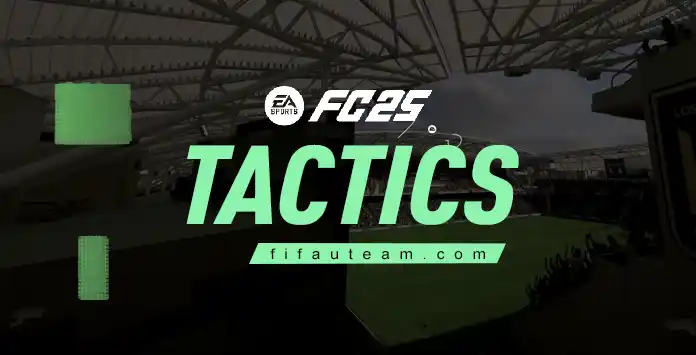
Team Tactics for Ultimate Team
With the removal of Work Rates and Player Instructions, a player’s behavior is now determined by their OVR (physical and mental attributes), HyperMotion (movement characteristics), Playstyles (on-the-ball skills), and Roles (off-the-ball abilities).
Unlike these individual parameters, which apply to players, Team Tactics are applied to the entire team as a whole. It gives you greater control over crafting your strategy and sharing it with friends. It also enables you to replicate real-world styles more accurately and adds variety to gameplay from match to match.
How to edit a FC 25 Team Tactic?
- From the main Ultimate Team screen, press R1/RB three times to select [Club];
- Select [Squad];
- Press L3 to popup [Squad Actions];
- Select [Team Management];
- Select a tactic and press [Edit].
- Formation;
- Build-Up Style;
- Defensive Approach.
| Build-Up Style ▲ |
| Deffensive Approach ▲ |
| Formations ▲ |
| Build Up Play ▼ |
| Chance Creation ▼ |
| Corners ▼ |
| Defensive Styles ▼ |
| Defensive Width ▼ |
| Depth ▼ |
| Free Kicks ▼ |
| Offensive Width ▼ |
| Players in Box ▼ |
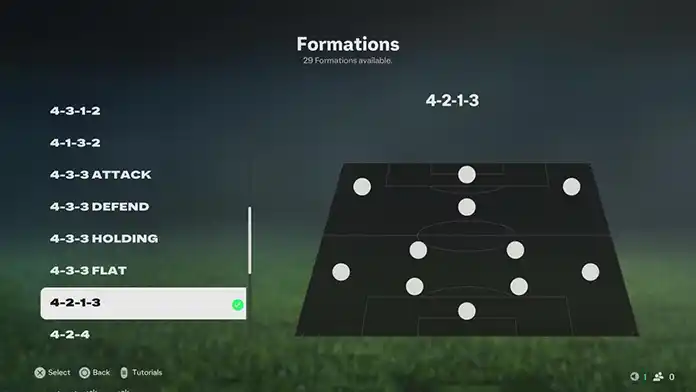
Formations
When creating a tactic, the first step is to choose a basis structure. Later, you can fine-tune individual player behavior with Roles and Focuses, but initially, you need to select one of the twenty-nine formations available in the game.
Formations are still fundamental in FC 25, and while they do not heavily dictate your style of play as much as they did in the past, they play a vital role in determining what positions and Roles you have available for your tactic.
The formation you choose is how your team defends and lines up when they don’t have the ball, so keep that in mind. Also, remember that Roles influence players’ behavior even in your base formation.
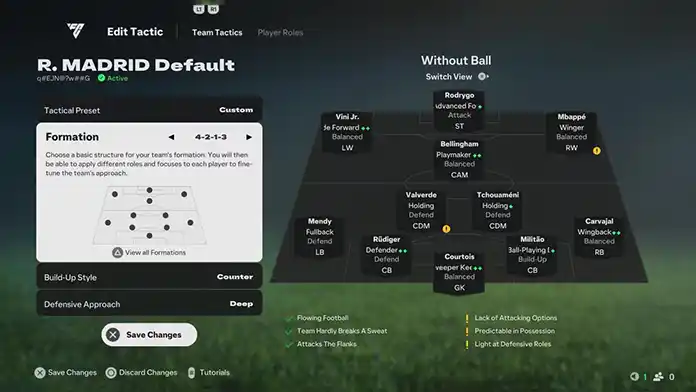
Build-Up Style
There are three Build-Up Styles that influence your team’s approach when moving the ball forward. These styles determine how quickly your team transitions from defense to attack and how they prioritize advancing up the pitch. The Role Familiarity further affects this transition.
These Build-Up Styles allow your team to either rush forward for a quick attack, ideal for when you need an immediate goal, or to build up play more methodically with additional passes and a focus on maintaining possession, which is useful when you’re under pressure.
Simply put, Build-Up Styles dictate how swiftly your team progresses from their own third of the field to the opponent’s third.
Short Passing
Players will come short to support the ball carrier rather than make forward runs. This more cautious approach allows the team to maintain its defensive shape for longer during the transition.
Balanced
Players will vary between forward runs and coming short. The team’s transition to their in-possession shape will be steady rather than sudden.
Counter
This approach encourages players to get in behind the opposition’s defense as the team transitions quickly from defense to attack.
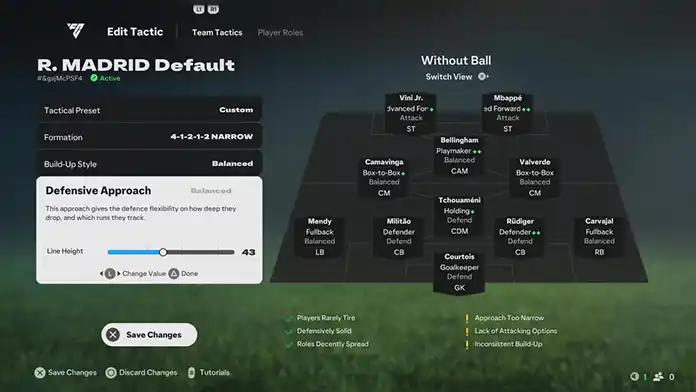
Defensive Approach
There are four Defensive Approaches, which combine Line Height/Depth, Pressure, and Run Tracking. Each one is directly connected to your team’s Line Height, which you can manually adjust between specific values. The higher the line, the higher up the field your defensive line sits.
Deep
A safety-first approach, with the defensive line dropping deeper to mark the opposition.
Balanced
This approach gives the defense flexibility on how deep they drop and which runs to track.
High
A riskier approach to defending, applying situational pressure, and adopting a high line that tends not to track opposition runs.
Aggressive
The most front-footed defensive approach, adopting a high line that focuses on applying the press immediately after losing possession and setting offside traps.
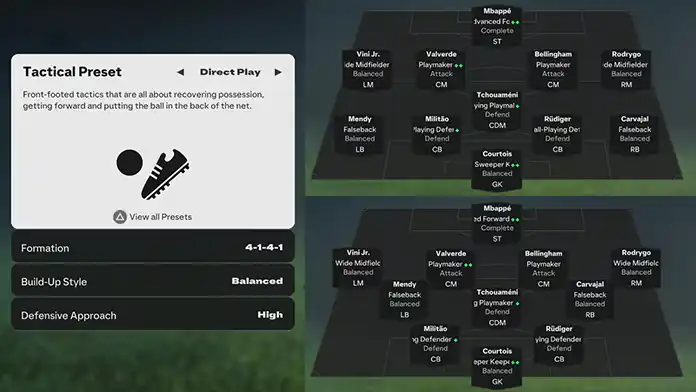
Tactical Presets
Tactical Presets are pre-made setups designed to reflect popular football strategies. They’re ideal for new players who are either unfamiliar with or prefer not to spend time customizing tactics. For experienced players, Presets offer a reliable foundation to build personalized strategies.
When you make any changes to a Preset, it automatically switches to Custom. Similarly, resetting a tactic returns it to its original state when you first accessed the tactics screen.
The system also provides dynamic feedback that analyzes your team, tactical settings, and player roles. This analysis highlights three strengths and three areas for improvement in your tactic.
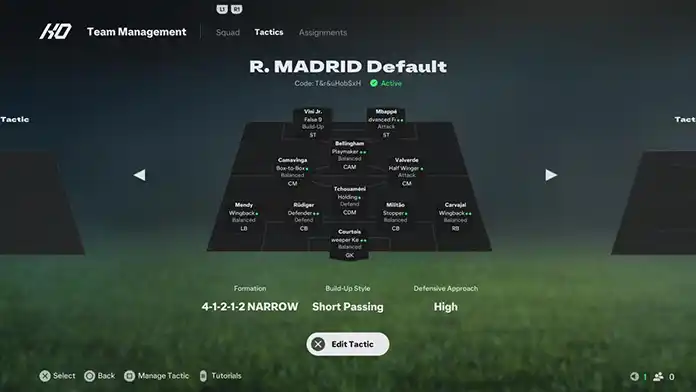
Custom Tactics
Custom Tactics give you full control over every detail of your team’s strategy. This option is best for experienced players who want to craft a personalized playstyle or replicate specific tactics.
In Football Club you can have up to five custom tactics. Each Custom Tactic can have a custom name and can have its own formation, tactical settings, and Player Roles. The only thing shared between them is the lineup.
In the custom tactics menu, you can create, import, edit, activate (the one you will use during gameplay), and manage your tactics. You can also rename, duplicate (up to five), or delete tactics, though you must always keep at least one.
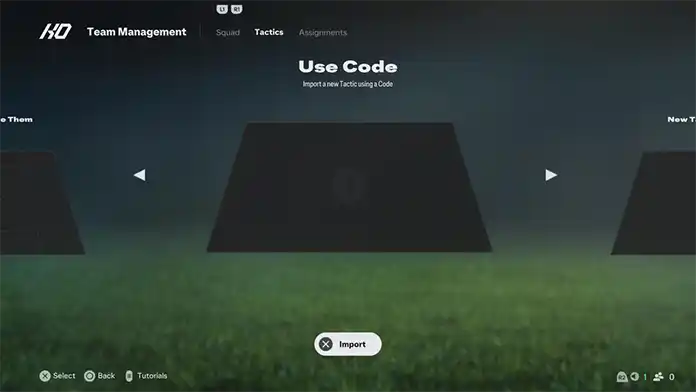
Code
Every tactic in the game has a unique 11-digit code associated with it. This code system allows you to easily share your best tactics or import those from others when you need some inspiration.
This code includes the Formation, Build-Up Style, Defensive Awareness, and the 11 Roles and Focuses, but does not include the tactic name.
The code is universal, working across any mode, console, or generation. To use it, simply select [Import Tactic] in the Custom Tactics menu and enter the shared code.
Frequently Asked Questions
Team tactics play a crucial role in shaping your team’s playing style. From formation settings to defensive approaches, Team Tactics gives you more control over creating your own strategy and sharing it with your friends.
A Team Tactic is made up of three main components: the chosen formation, the Build-Up Style, and the Defensive Approach. These elements determine how your team is organized on the field, both in possession and in defense, allowing you to tailor your strategy for different match situations.
FC 25 has four Defensive Approaches (Deep, Balanced, High,and Aggessive), which combine Line Height/Depth, Pressure, and Run Tracking. Each Defensive Approach is directly connected to your team’s Line Height, which you can manually adjust between specific values. The higher the line, the higher up the field your defensive line sits.
Here’s how each approach affects your team:
- Deep: A safety-first approach where the defensive line drops deeper to mark the opposition.
- Line Height values: 1 – 30
- Default Line Height: 25
- Run Tracking: Line drops with runs
- Pressure: None
- Balanced: Provides flexibility, allowing the defense to adjust its depth and track runs as needed.
- Line Height values: 31 – 60
- Default Line Height: 50
- Run Tracking: Line is flexible in tracking runs
- Pressure: None
- High: A riskier approach with a high defensive line, applying situational pressure but not tracking opposition runs closely.
- Line Height values: 61 – 90
- Default Line Height: 70
- Run Tracking: Line rarely tracks runs
- Pressure: Minimal
- Aggressive: The most proactive defensive approach with a high line, focusing on immediate pressing after losing possession and setting offside traps.
- Line Height values: 91 – 100
- Default Line Height: 95
- Run Tracking: Line never tracks runs; steps up to maintain the highest line possible
- Pressure: On heavy touch
- Extra stamina drain
In FC 25, there are three Build-Up Styles that influence how your team advances up the pitch when in possession of the ball. These styles determine both the speed of your transition from defense to attack and how quickly your team moves forward.
Quick Attack: This style prioritizes fast breaks and rapid movement up the field, ideal for situations where you need an immediate goal.
Balanced Build-Up: This approach balances speed with control, allowing your team to gradually build up play with more passes and maintain possession, which is useful when under pressure.
Slow Build-Up: This style focuses on a more deliberate approach, emphasizing careful buildup and possession before pushing forward.
Think of Build-Up Styles as dictating how swiftly your team transitions from its own defensive third to the opponent’s attacking third.
Quick Attack: This style prioritizes fast breaks and rapid movement up the field, ideal for situations where you need an immediate goal.
Balanced Build-Up: This approach balances speed with control, allowing your team to gradually build up play with more passes and maintain possession, which is useful when under pressure.
Slow Build-Up: This style focuses on a more deliberate approach, emphasizing careful buildup and possession before pushing forward.
Think of Build-Up Styles as dictating how swiftly your team transitions from its own defensive third to the opponent’s attacking third.
Here is how each style affects your team:
- Short Passing: Players will come short to support the ball carrier rather than make forward runs. This more cautious approach allows the team to maintain its defensive shape for longer during the transition.
Build-up characteristic: come short
Transition time: patient - Balanced: Players will vary between forward runs and coming short. The team’s transition to their in-possession shape will be steady rather than sudden.
Build-up characteristic: mixed
Transition time: normal - Counter: This approach encourages players to get in behind the opposition’s defense as the team transitions quickly from defense to attack.
Build-up characteristic: forward runs
Transition time: quick
In Football Club, there are a few base Presets (in specific modes like Kick-Off) and special Presets that are suggested during gameplay with the Tactical Suggestion.
Changing any aspect of a Preset will convert it to a Custom Tactic. An incompatible setting, which breaks the Preset’s configuration, will be marked by a broken chain symbol.
In most modes, there is no downside to using a Custom Tactic instead of a Preset, except in Career Mode, so make sure to check the in-game prompts.
You will receive a warning popup if you try to save a tactic with an incompatible setting. Accepting the warning will save your tactic and change the Preset to Custom, while dismissing it will discard your changes.
In most modes, there is no downside to using a Custom Tactic instead of a Preset, except in Career Mode, so make sure to check the in-game prompts.
You will receive a warning popup if you try to save a tactic with an incompatible setting. Accepting the warning will save your tactic and change the Preset to Custom, while dismissing it will discard your changes.
The Reset Tactic function appears after you save or discard your changes. Resetting a tactic will put it back in the state it had once you entered the tactic screen. This means that no matter how many times you save your tactics, this button will revert them back to their original state. You can think of it like a massive undo button.
Bear in mind that leaving the Team Tactics menu will permanently save your tactics.
Bear in mind that leaving the Team Tactics menu will permanently save your tactics.
The Tactical Summary is a dynamic feedback that analyzes your tactic by assessing the team, your tactical settings, and player Roles. You will receive insights into three strengths and three areas for improvement, providing a balanced view of your tactic’s performance.
The Summary evaluates six aspects:
The Summary evaluates six aspects:
- Attack and Defence: These are based on the number of Positions, Roles, and Focuses that emphasize attacking or defending. A well-balanced tactic can be effective in both areas.
- Width: This measures how wide your team is both in possession and out of possession. It depends on your formation, assigned Roles, and the level of wide attacking or defensive support.
- Endurance: This reflects how much your tactic relies on players moving to different positions throughout the game. Factors include the variation between playing with and without the ball and certain Focuses like Roaming.
- Length: This shows how spread out your team is vertically. It takes into account your Defensive Approach, line height, and the spacing between attackers and defenders.
- Build-Up: This indicates how much focus your team places on building attacks. Key elements include pass lanes, Role proximity, Role creativity, and the chosen Build-Up Style.